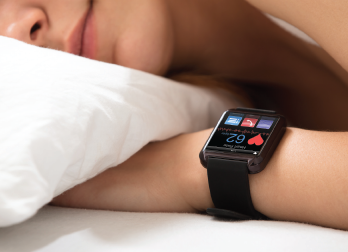
Andrey_Popov / shutterstock.com
SNOWMASS VILLAGE, COLO.—A major workforce shortage, a population of patients taking immunosuppressants where safety concerns and the patient experience are critical, and an increasing focus on remote patient monitoring and telehealth are driving a discussion regarding the role digital wearables play in rheumatologic care.
“We need to be more thoughtful and efficient in taking care of people because we won’t always have the luxury of bringing patients back in three months for medication management simply because it’s time to perform monitoring lab tests,” noted Jeffrey Curtis, MD, MS, MPH, during his presentation on digital health and rheumatology at the 2020 ACR Winter Symposium. Dr. Curtis is the Harbert Ball Professor of Medicine in the Division of Clinical Immunology & Rheumatology, University of Alabama at Birmingham (UAB).
This past year, Dr. Curtis moved to Los Angeles to complete a sabbatical, studying at Cedars-Sinai Medical Center, UCLA, and elsewhere to understand how specialty care professionals treating chronic illnesses, such as diabetes, are applying wearable technology data to improve patient care. For example, digital data reports related to a patient’s mobility obtained from a hospital-provided Fitbit plus a biosensor-equipped knee brace following joint replacement can help inform a healthcare provider much earlier about how well the patient is rehabilitating than if the patient had to wait for a face-to-face appointment.
Dr. Curtis is currently engaged in research at UAB to understand how wearable data can be used to personalize care.
Gathering Meaningful Data
Digital wearable technologies offer value to rheumatology patients and physicians in a number of ways, Dr. Curtis explained. Wearable technologies give patients new opportunities to be more empowered in managing their health and accessing their health data. Access to care can also be increased, and this virtual access can lower healthcare costs. Digital technology that can enable remote health monitoring is particularly important now, given the challenges related to the COVID-19 pandemic patients face in traveling to a physician’s office.
For rheumatologists, wearable data can provide more efficient, accurate information on a patient’s health. Example: The technology can be used to see how frequently and to what intensity a patient has exercised in real time and how well they are sleeping rather than having the patient describe this information in a later appointment.
Collecting data directly from patients via wearable technology can also provide new avenues for research, automating data capture for clinical trials and research studies generating real-world evidence.
Practices that submit data to registries, such as the ACR’s Rheumatology Informatics System for Effectiveness (RISE) registry, may see particular benefit. Given that a substantial amount of care may be delivered outside a rheumatologists’ office, patients can inform the totality of their healthcare experience so their rheumatologist has more complete information. And patient-reported outcomes and other patient-generated health data (e.g. depression, anxiety, flare, medication adherence) can be captured on mobile technology (e.g. by smartphone) and integrated with the electronic health record (EHR) and populate an EHR-based registry.
“The notion that you can get an answer about how to care for the patient in front of you based on data from patients cared for by more than 1,000 physician practices, knowing what they did and then what happened, is exciting to pursue. Wearable technology as a component of this type of integrated data platform has tremendous potential,” said Dr. Curtis.
The key to making wearable data meaningful is understanding how to offer value based on what the data tell us. Dr. Curtis said, “We need to be asking how we can filter data streams to pinpoint what is important and what is actionable. There is a lot of noise in digital data, and we need to focus on the most important signals.” For example, if a wearable device indicates the patient is experiencing a flare, then clinicians can intervene more rapidly to reduce the severity and duration of the flare and, thus, improve outcomes. Even better, we want to build on this approach to predict and potentially prevent a flare in the near future.
Digital Wearable Trends
Currently in rheumatology, Dr. Curtis said data from digital wearables are being used most commonly for patients who seem to be doing well and can be monitored with wearable data to inform physicians of their health status. Although the state of the art of digital wearables for rheumatology patients currently lies in consumer-grade devices (e.g., Fitbit, Apple Watch), digital wearables in the near future may include specialized devices prescribed as part of a patient’s care.
Several forward-looking trends with digital wearable technologies may hold promise in the rheumatology practice setting:
- Having patients with systemic lupus erythematosus wear an ultraviolet (UV) sensor on their clothing to track their UV exposure and monitor how that exposure affects their health status (e.g., rash, flare);
- Assessing specific comorbidities common to patients with rheumatic condition (e.g., patients in a home sleep study may wear a sleep monitoring device, rather than having to spend the night in a sleep laboratory; those with chronic conditions, such as interstitial lung disease, may have their cough and other respiratory activities passively monitored);
- For patients undergoing joint replacement procedures, prescribing a biosensor brace with sensors that talk to their smartphone to monitor postoperative movement, track rehabilitation and assess desired progress toward optimal range of motion;
- Prescribing increasing activity by providing a digital pedometer and setting a step count goal for a patient with rheumatoid arthritis to monitor how an increase in exercise can reduce fatigue (Note: This approach has been tested as part of a controlled trial and showed that exercise correlated with reduced fatigue); and
- Using virtual reality to digitize a patient’s future self to facilitate shared decision making about treatment choices.
Dr. Curtis challenged rheumatologists to proactively reach out to software engineers and artificial intelligence companies with ideas and needs for digital wearable technology applications in rheumatology care.
Proactively Addressing Barriers
As digital wearable technologies emerge and evolve, two significant challenges to successful application in the practice setting remain: getting patients access to the technology and getting them to use and share data.
Digital wearables on the market for consumer purchase are costly and not available to everyone, Dr. Curtis said. He also asked: “Are you asking patients to buy their own device, or will you (or a research study) provide it? If we are using it to monitor people ‘in the wild,’ we need to make sure that we aren’t excluding patients who may not own such technology. These patients may be most at risk for bad outcomes, yet perhaps more likely to benefit from such technology.”
He stressed the value of helping patients understand how they will benefit from wearing a device and sharing collected data with their healthcare team. He noted that “long-term patient engagement is key.”
Previous research studies using digital wearables for data collection have found limited patient adherence. Privacy and security concerns are also on patients’ minds.
“People want to know what they are getting for sharing their personal data, who has access to their data and for what,” said Dr. Curtis. “If their doctor is going to use the information to help them, that’s a highly compelling use case, and it needs to be done in a secure and transparent way.”
This challenges rheumatologists to find tangible ways to give patients value for sharing their data and demonstrate how their care was improved as a result.
Given that COVID-19 has made the concept of remote patient monitoring more important than ever, the opportunities abound, but digital technology and remote patient monitoring must be implemented in a careful, thoughtful fashion.
Carina Stanton is a freelance science journalist based in Denver.


